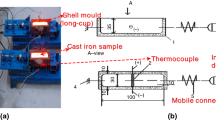Abstract
Lamellar graphite cast iron was investigated with carbon equivalents varied between CE = 3.4 and 4.26, cast at various cooling rates between 0.195 and 3.5 °C s−1 covering the limits used for technical applications in the production of complex-shaped lamellar graphite cast iron. Registered cooling curves displaced in two positions in the casting were used to predict the solidification and microstructure formation mechanisms. The predicted volume fraction of primary austenite was compared with the fraction of primary austenite measured on colour micrographs with the help of image analyses. A good correlation has been obtained for medium and slow cooling conditions, while a less good correlation at fast cooling condition was attributed to the used protective environment to preserve thermocouples. The observed fraction and the predicted fraction of primary austenite were in good correlation and followed a consequent variation dependent on the carbon equivalent. Furthermore, the quality of the prediction was dependent on the used numerical algorithm involving cooling information from either one or two thermocouples.













Similar content being viewed by others
Abbreviations
- \( C_{\text{p}} \) :
-
Heat capacity (J kg−1 K−1)
- \( C_{\text{v}} \) :
-
Volumetric heat capacity (J m−3 K−1)
- \( {\text{CE}} \) :
-
Carbon equivalent
- \( \dot{T} \) :
-
Cooling rate (°C s−1)
- T :
-
Temperature (°C)
- Z F :
-
Fourier zero line (°C s−1)
- Z N :
-
Newtonian zero line (°C s−1)
- \( f_{\text{s}} \) :
-
Fraction solidified metal
- \( f_{\gamma }^{\text{A}} \) :
-
Fraction liquid
- k :
-
Thermal conductivity (Wm−1 K−1)
- \( \dot{q}_{\text{sol}} \), \( q_{\text{s}} \) :
-
Released heat during solidification used in heat conduction equation (Wm−3)
- \( t_{\text{b}} \) :
-
Start time of solidification (s)
- \( t_{\text{e}} \) :
-
End time of solidification (s)
- \( \alpha \) :
-
Thermal diffusivity (m2 s−1)
- \( \nabla^{2} T \) :
-
Laplace operator
- \( \rho \) :
-
Density (kg m−3)
References
Diószegi A, Svensson IL. On the problems of thermal analysis of solidification. Mat Sci Eng A Struct. 2005;413–414:474–9.
Bäckeryd L, Kroll E, Tamminen J. Solidification characteristics of aluminum alloys, vol. 1. Oslo: Skanaluminum; 1986.
Fras E, Kapturkiewicz W, Lopez HF. The solidification kinetics of cast iron using an improved thermal analysis technique. Int J Cast Metal Res. 1993;6(3):137–42.
Diószegi A, Hattel J. An inverse thermal analysis method to study the solidification in cast iron. Int J Cast Metal Res. 2004;17(5):311–8.
Svidró JT, Diószegi A, Tóth J. The novel application of Fourier thermal analysis in foundry technologies. J Therm Anal Calorim. 2014;115(1):331–8.
Upadhya KG, Stefanescu DM, Lieu K, Yeager DP. Computer-aided cooling curve analyses: principles and applications in metal casting. Tran Am F. 1989;97:60–6.
Riposan I, Chisamera M, Stan S, Barstow M. Identifying chill tendency of cast iron melts by thermal analyses. Int J Cast Metal Res. 2013;26:152–9.
Emadi D, Whiting LV. Determination of solidification characteristics of al-si alloys by thermal analysis. Tran Am F. 2002;110:285–96.
Larranga P, Guttierez JM, Loizaga A, Sertucha J, Suarez R. A computer-aided system for melt quality and shrinkage propensity evaluation based on the solidification process of ductile iron. Tran Am F. 2008;116:547–61.
Xu JF, Liu F, Zhang D, Jian ZY. An analytical model for solidification of undercooled metallic melts. J Therm Anal Calorim. 2015;119(1):273–80.
Barlow JO, Stefanescu DM. Computer-aided cooling curve analyses revisited. Tran Am F. 1997;105:349–54.
Emadi D, Whiting LV, Nafisi S, Ghomashchi R. Applications of thermal analysis in quality control of solidification process. J Therm Anal Calorim. 2005;81(1):235–42.
Diószegi A, Svensson IL. Interpretation of solidification by thermal analysis of cooling rate. Trans Indian Inst Metals. 2005;58(4):611–6.
Diószegi A, Fourlakidis V, Lora R. Austenite dendrite morphology in lamellar graphite iron. Int J Cast Metal Res. 2015. doi:10.1179/1743133615Y.0000000018.
Kurz W, Fisher DJ. Fundamentals of Solidification. 3rd ed. Aedermannsdorf: Trans Tech Publications; 1989.
Stefanescu DM. competitive growth of eutectic and dendritic phases in Stefanescu DM. Science and engineering of casting solidification. New York: Kluwer Academic/Plenum Publishers; 2002. p. 204–6.
Acknowledgements
The present work was performed within the Casting Innovation Centre and financed by the Swedish Knowledge Foundation. Cooperating parties in the project are Jönköping University, Swerea SWECAST AB, Scania CV AB and Volvo Powertrain Production Gjuteriet AB. Participating persons from these institutions/companies are acknowledged.
Author information
Authors and Affiliations
Corresponding author
Appendices
Appendix 1
Appendix 2
Rights and permissions
About this article
Cite this article
Diószegi, A., Diaconu, VL. & Fourlakidis, V. Prediction of volume fraction of primary austenite at solidification of lamellar graphite cast iron using thermal analyses. J Therm Anal Calorim 124, 215–225 (2016). https://doi.org/10.1007/s10973-015-5158-z
Received:
Accepted:
Published:
Issue Date:
DOI: https://doi.org/10.1007/s10973-015-5158-z


















